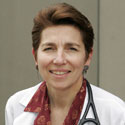Temple University takes aim at community viral loads to reduce HIV

Ellen Tedaldi, director of Temple’s Comprehensive HIV program.
People around the globe will mark World AIDS Day today (Dec. 1) with events and campaigns designed to raise public awareness and break down the stigma surrounding HIV. But healthcare professionals at Temple are working year-round to combat the disease by focusing on reducing the community viral loads in targeted groups.
It’s an approach that has gained momentum in the past two years, and it is still evolving and undergoing evaluation.
“If we can get enough people tested for HIV and on therapy for HIV, we can potentially reduce the risk for the community as a whole,” said Ellen Tedaldi, director of Temple’s Comprehensive HIV program.
To reach as many community members as possible, Tedaldi and her team work with health centers, churches and schools across Philadelphia to promote awareness of HIV/AIDS, remove some of the stigma attached to the disease and, most importantly, test as many members of the community as possible and get those who are infected into treatment.
Their biggest roadblock is misinformation. Myths are widespread, including misconceptions that married individuals don’t get HIV and that it only affects certain races. To correct such falsehoods, Temple’s program takes its message directly to the people — at venues such as health fairs or church events.
“At a health fair, you’d get a blood screening or a glucose test, so why not get an HIV test at the same time,” said Tedaldi. “Part of the overall goal is to have HIV become a routine test; to have people realize, ‘Hmm, I might have been exposed.’”
At these events, representatives of the program set up information booths, hand out educational literature and hold panel discussions led by HIV patients, whose presence helps put a face on the disease.
“The trick is to tailor your message around the mindset of the individuals,” said Princess Graham, program coordinator for the Comprehensive HIV Program. With older people, she said, it’s important to emphasize that they are just as vulnerable to HIV as anyone else.
When speaking to teens, Graham encourages them to stop and think. “We try to promote abstinence, but we need to be realistic,” she said. “In schools, they almost don’t want to hear it, but as they listen, they start to engage more and ask questions. Students come up to me afterward to ask about getting tested. They’re glad they have someone to talk with about it.”
Making people aware of their HIV status helps stop the spread of the disease in two ways, Tedaldi said. First, those who are unaware of their HIV status and have high viral levels have a greater chance of transmitting the virus to others, especially early in the infection. Once they are aware of their HIV status, they can change their sexual behavior to reduce risk to partners and contacts. Second, after beginning treatment, viral levels decrease, reducing the risk of transmission.
In 2008, more than 24,500 Philadelphians were infected with HIV. Today, Philadelphia’s rate of infection is five times the national average. Through her program, Tedaldi is working to change that statistic.
“If you can reach the larger community, you can get people who know they’re HIV positive and treat them early before they transmit to others,” she said.
—Elizabeth DiPardo